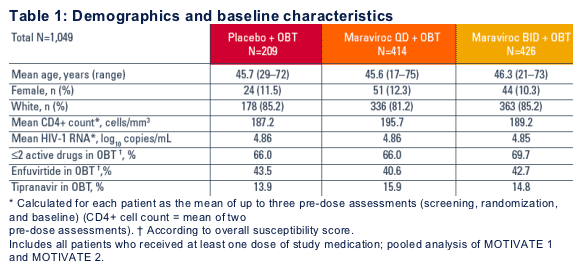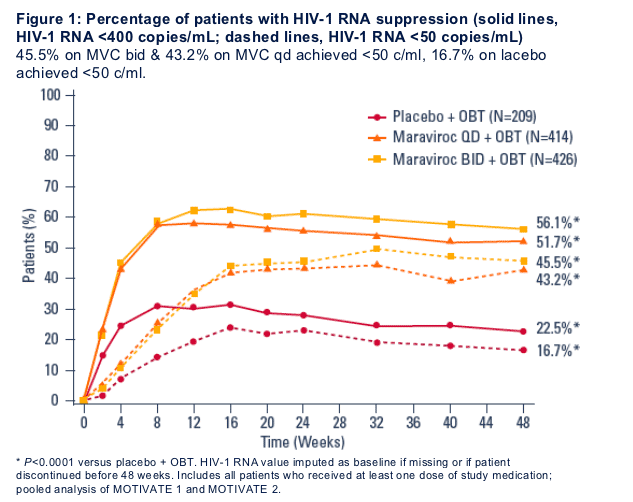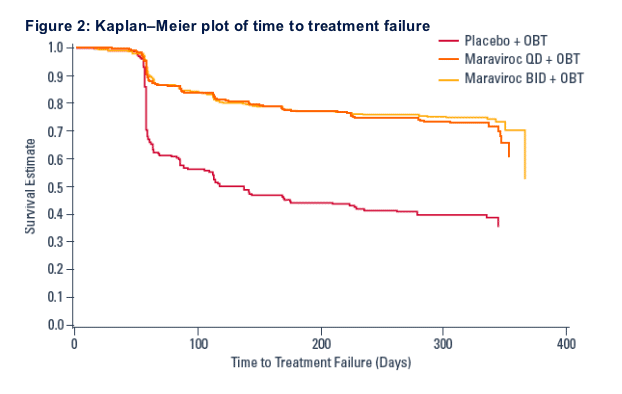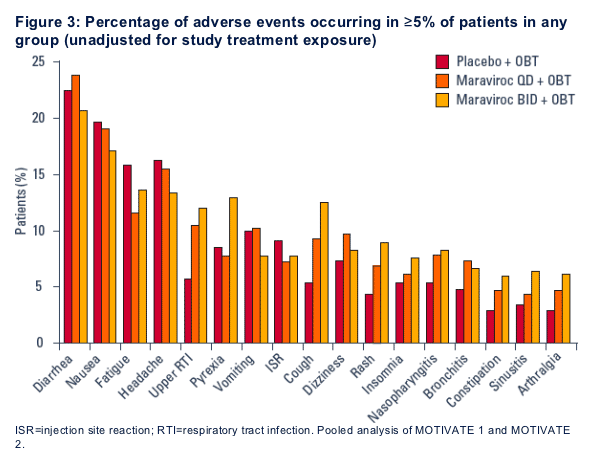 |
 |
 |
| |
Maraviroc 48-Weeks Safety, Efficacy in Treatment-Experienced MOTIVATE 1 and 2 Study Pooled Analysis
|
| |
| |
Efficacy and Safety of Maraviroc Plus Optimized Background Therapy in Treatment-experienced Patients Infected with CCR5-tropic HIV-1: 48-week Combined Analysis of the MOTIVATE Studies
--Pooled Analysis of MOTIVATE 1 & 2
Reported by Jules Levin
CROI 2008, Feb 3-6 Boston
D Hardy1, J Reynes2, I Konourina3, D Wheeler4, S Moreno5, E van der Ryst3, W Towner6, A Horban7, H Mayer8, and J Goodrich8
1David Geffen School of Medicine at UCLA, Los Angeles, CA, USA; 2University Hospital of Montpellier, Montpellier, France; 3Pfizer Global Research and Development, Sandwich, UK; 4Infectious Diseases Physicians, Inc., Annandale, VA, USA;
5Hospital Ram—n y Cajal, Madrid, Spain; 6Kaiser Permanente, Los Angeles, CA, USA; 7Szpital Zakazny Centrum Diagnostyki i Terapii AIDS, Warsaw, Poland; 8Pfizer Global Research and Development, New London, CT, USA
AUTHOR CONCLUSIONS
· Maraviroc (QD or BID) + OBT demonstrated significantly greater virologic suppression rates and increases from baseline in CD4+ cell counts at Weeks 24 and 48 compared to placebo + OBT in this combined analysis. SEE GRAPHS
· The benefit of maraviroc + OBT over placebo + OBT was apparent even in subgroups of patients with adverse prognostic factors, such as high screening viral load or low baseline CD4+ cell count.
· Maraviroc + OBT demonstrated a similar safety profile compared to placebo + OBT, despite considerably greater exposure to study treatment in the maraviroc groups.
· There was no increase in AIDS-defining events (infections or malignancies) or non-AIDS- defining malignancies in maraviroc (QD or BID) + OBT versus placebo + OBT.
· No deaths reported during the study or up to 28 days of stopping study drug were considered to be related to study medication.
· In conclusion, these results demonstrate that, in treatment-experienced patients with R5 virus, maraviroc combined with OBT provides sustained antiretroviral efficacy and tolerability through 48 weeks.
BACKGROUND
· Maraviroc (Selzentry/Celsentri) is an approved CCR5 antagonist with anti-viral activity against CCR5-tropic (R5) HIV-1.1
· The efficacy and safety of maraviroc in treatment-experienced patients with R5 virus have been assessed in two randomized, double-blind, placebo-controlled Phase 3 studies; MOTIVATE 1 (USA, Canada) and MOTIVATE 2 (Europe, Australia, USA).2-5
· In both studies, maraviroc (QD or BID) + optimized background therapy (OBT) demonstrated significantly greater virologic and immunologic efficacy and a similar safety profile compared to placebo + OBT in the Week 48 primary analysis. These data have been presented independently.2,3
· Since the study design, inclusion/exclusion criteria, conduct, monitoring, and statistical analyses of MOTIVATE 1 and MOTIVATE 2 were identical, pooling of data from the two studies was appropriate, resulting in larger sample sizes for
subgroup analyses.6
· We present the results of a planned analysis of pooled data, at Week 48, from the two MOTIVATE studies.
METHODS
· Patients with triple-class drug experience and/or triple-class drug resistance, R5 virus only (Trofile, Monogram Biosciences), and HIV-1 RNA ≥5,000 copies/mL were randomized in a 1:2:2 ratio to placebo, maraviroc QD, or maraviroc BID, in combination with OBT. 2-5
· OBT consisted of 3-6 antiretrovirals +/- low-dose ritonavir.
Investigational agents (including darunavir, etravirine, and raltegravir) were not used as part of the OBT.
--Patients receiving a PI (except tipranavir) and/or delavirdine - potent CYP3A4 inhibitors - in their OBT received 150 mg doses of maraviroc; all other patients received 300 mg doses of maraviroc.
· Each study was individually powered to show superiority of either experimental arm compared to the placebo + OBT group.
· The primary endpoint was the change from baseline in log10-transformed plasma HIV-1 RNA levels at 48 weeks. Secondary endpoints included categories of virologic response (percentage of patients with HIV-1 RNA levels <50 and <400 copies/mL), change from baseline in CD4+ cell count, and time to treatment failure.
RESULTS
Study population
· The combined dataset included a total of 1,049 patients who each received at least one dose of maraviroc QD + OBT (n=414), maraviroc BID + OBT (n=426), or placebo + OBT (n=209).
· Demographics and baseline characteristics were similar across the three treatment groups (Table 1).
· The majority of patients had two or fewer potentially active drugs in their OBT regimen according to overall susceptibility score at screening (Table 1).

Efficacy
Both maraviroc treatment groups showed greater reductions from baseline in HIV-1 RNA copies/mL at 48 weeks (primary endpoint) compared to placebo + OBT (Table 2).

For each of the secondary virologic endpoints, including the rates of virologic suppression to <400 and <50 copies/mL at Week 48 (Figure 1), the responses in the maraviroc groups were also significantly better than in the placebo group (P<0.0001).

· CD4+ cell count increases up to 48 weeks were also more favorable in both the maraviroc groups than the placebo group.
- The mean change from baseline in CD4+ cell count
(last-observation-carried-forward approach used to impute missing values) was +61 cells/mm3 in the placebo group, compared to +116 and +124 cells/mm3 in the maraviroc QD and BID groups, respectively.
· Time to treatment failure was similar in the maraviroc QD and BID treatment groups and significantly longer in these groups than in the placebo treatment group (Figure 2).

· When treatment response was analyzed by screening viral loads and baseline CD4+ cell counts, the benefit of maraviroc (QD or BID) + OBT over placebo + OBT remained constant across all strata, regardless of whether patients initiated treatment with high viral loads or low CD4+ cell counts (Table 3).

Safety
· Pooled analysis revealed no new or unique safety findings at Week 48.
· There were no clinically relevant differences in the safety profile between maraviroc (QD and BID) + OBT and placebo + OBT over 48 weeks of treatment (Table 4, Figure 3).
- This was despite the longer exposure to study treatment in patients in the maraviroc treatment groups (more than 300 patient-years per group) versus the placebo group (111 patient-years) (Table 4), associated with the higher rate of discontinuation in the placebo group.
· Adverse events, serious adverse events, discontinuations due to adverse events, and laboratory abnormalities (including grade 3/4 transaminase elevations) occurred with similar frequency between treatment groups (Table 4).
· The incidence of Category C (AIDS-defining) events was comparable across treatment groups (Table 4).
· The most common adverse events in all treatment groups were diarrhea, nausea, fatigue, and headache (Figure 3), with similar rates for all treatment groups.
· More deaths were recorded in patients receiving maraviroc versus those receiving placebo during the safety analysis reporting period or within 28 days of discontinuing study drug. Deaths were from various causes and none of the deaths were considered to be related to study medication (Table 4).

Discontinuation due to adverse events: 5.3% in placebo; 5.8% in MVC QD, 4.9% in MVC BID. Grade 3 adverse events: 22% in placebo, 20.3% in MVC QD, 24.4%. Grade 4 events: 7.7% placebo, 8.9% MVC QD, 10.6% MVC BID, category C events: 7.7% placebo, 7.0% MVC QD, 5.4% MVC BID. Non-HIV malignancies: 5.3% placebo, 2.9% MVC QD, 4.5% MVC bid. Deaths: 1.0% placebo, 1.4% MVC QD, 2.1% MVC BID.
Liver function
AST: grade 3 (>5-10xULN): 2.9% placebo, 2.9% MVC QD, 3.3% MVC bid; grade 4 (>10xULN): 0 placebo, 1% MVC QD, 1.4% MVC bid. ALT grade 3 (>5-10xULN): 2.9% placebo, 3.9% MVC qd, 1.7% MVC bid; ALT grade 4 (>10xULN): 0.5% placebo, 0.5% MVC qd, 1% MVCbid. Total bilirubin grade 3 (>2.5xULN): 3.9% placebo, 6.9% MVC qd, 5.0% MVC bid; grade 4 (>5xULN): 1.5% placebo, 1.2% MVC qd, 0.5% MVC bid.

REFERENCES
1. Dorr P, et al. Antimicrob Agents Chemother 2005; 49:4721-4732.
2. Lalezari J, et al. 47th ICAAC 2007; Presentation H-718a.
3. Fatkenheuer G, et al. 11th EACS 2007; Presentation PS3/5.
4. Lalezari J, et al. 14th CROI 2007; Presentation 104bLB.
5. Nelson M, et al. 14th CROI 2007; Presentation 104aLB.
6. Gulick RM, et al. 4th IAS 2007; Presentation WEPEB116LB.
7. Hoepelman IM, et al. 11th EACS; Poster LBP7.9/1.
|
| |
|
 |
 |
|
|